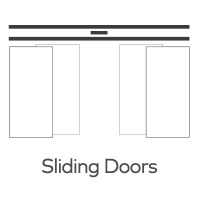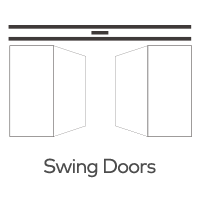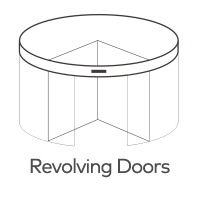Quels capteurs utilisent les portes automatiques?
Les portes automatiques permettent un accès sans faille et mains libres dans une variété d'espaces publics et commerciaux, grâce à des capteurs qui détectent quand quelqu'un s'approche ou se tient près de la porte. Ces capteurs sont responsables de l’activation du système moteur de la porte, lui permettant d’ouvrir et de fermer automatiquement. Plusieurs types de capteurs peuvent être utilisés dans les portes automatiques, chacun adapté à des applications et environnements spécifiques. Dans cet article, nous allons examiner les capteurs les plus courants utilisés dans les portes automatiques et comment ils fonctionnent. "="" strong"="" style="">
1. Les capteurs de mouvement sont parmi les capteurs les plus utilisés dans les portes automatiques et sont conçus pour détecter le mouvement dans une certaine plage. Ils sont très réactifs, ce qui les rend idéaux pour les zones fréquentées comme les centres commerciaux, les aéroports et les bâtiments de bureaux. - Capteurs infrarouges (IR) : Les capteurs IR détectent la présence d'objets chauds en détectant le rayonnement infrarouge émis par des personnes ou des animaux. Lorsque quelqu'un entre dans la zone de détection du capteur, le capteur déclenche la porte pour s'ouvrir. Les capteurs IR sont très efficaces à proximité, ce qui les rend appropriés pour les entrées où la porte doit s'ouvrir quand une personne est à proximité.
- Capteurs à micro-ondes: Les capteurs à micro-ondes émettent des signaux à micro-ondes, qui se réfléchissent sur les objets en mouvement et retournent au capteur. En mesurant ces réflexions, le capteur peut détecter le mouvement et signaler l'ouverture de la porte. Les capteurs micro-ondes sont plus sensibles que les capteurs IR et peuvent détecter le mouvement à plus grandes distances, ce qui les rend idéaux pour le trafic élevé ou les grandes entrées.
2. Capteurs de proximité
Les capteurs de proximité détectent la présence d'une personne ou d'un objet sans nécessiter de mouvement réel. Cela est utile dans les environnements où la porte doit rester ouverte aussi longtemps que quelqu'un est à proximité, comme les entrées d'hôpitaux ou les zones d'accessibilité où les utilisateurs peuvent avoir besoin de temps supplémentaire.
- Capteurs de proximité capacitifs: Les capteurs capacitifs mesurent les changements dans le champ électrique près de la porte. Quand une personne ou un objet entre dans ce champ, le capteur détecte le changement et ouvre la porte. Ces capteurs sont souvent utilisés dans des applications nécessitant un contrôle précis, car ils peuvent être ajustés pour la sensibilité.
- Capteurs à ultrasons: Les capteurs à ultrasons émettent des ondes sonores qui rebondissent lorsqu'ils frappent un objet, et le capteur détecte l'écho pour déterminer si quelque chose est présent. Ces capteurs sont efficaces pour détecter des personnes ou des objets dans une plage déterminée et sont moins affectés par l'éclairage ou les changements environnementaux que d'autres types de capteurs.
3. Les capteurs de pression sont une autre option pour les portes automatiques, en particulier les modèles plus anciens, et sont encore couramment utilisés dans certaines applications commerciales. Ils fonctionnent en détectant le poids sur un tapis ou un tapis près de la porte. - Tapis de pression: Les capteurs de pression sont généralement intégrés dans des tapis de sol placés à l'entrée de la porte. Lorsque quelqu'un marche sur le tapis, le capteur détecte le poids et signale l'ouverture de la porte. Ces tapis sont durables et souvent utilisés dans des environnements industriels ou lourds. Cependant, les capteurs de pression sont progressivement remplacés par d'autres types de capteurs qui offrent plus de flexibilité et de portée.
4. Capteurs optiques (laser)
Les capteurs optiques ou laser utilisent des faisceaux lumineux pour créer un champ de détection près de la porte. Quand un objet ou une personne interrompe le faisceau, le capteur s’active et ouvre la porte.
- Capteurs laser: Ces capteurs utilisent la lumière infrarouge ou laser pour détecter des objets dans une plage spécifique. Les capteurs laser sont très précis et peuvent être configurés pour détecter des zones très spécifiques, ce qui les rend utiles dans les domaines où la précision est importante, comme dans les entrepôts automatisés ou les installations ayant des besoins de sécurité élevés.
- Capteurs photoélectriques: Les capteurs photoélectriques fonctionnent de manière similaire aux capteurs laser en émettant un faisceau lumineux à travers une zone définie. Quand quelqu'un traverse le faisceau lumineux, il déclenche la porte pour s'ouvrir. Ces capteurs sont souvent utilisés pour des applications industrielles où la sécurité est primordiale, car ils peuvent détecter si quelqu'un est dans le chemin de la porte.
5. Capteurs combinés
De nombreuses portes automatiques modernes utilisent une combinaison de capteurs pour améliorer la fiabilité et la sécurité. Par exemple, une porte peut avoir à la fois un capteur de mouvement à micro-ondes et un capteur infrarouge. Le capteur micro-ondes détecte le mouvement à distance, incitant la porte à se préparer à s'ouvrir, tandis que le capteur infrarouge vérifie qu'une personne est à portée avant d'ouvrir complètement. Cette combinaison assure que la porte s’ouvre en douceur et ne se ferme que lorsqu’elle est en sécurité.
Choisir le bon capteur pour votre porte automatique
Le capteur idéal dépend de facteurs tels que le volume de trafic, l'environnement et les exigences spécifiques. Voici un guide rapide des types de capteurs basés sur l'application:
- Zones à haut trafic: Les capteurs à micro-ondes sont préférés en raison de leur capacité à détecter le mouvement à distance et à gérer de grands volumes de personnes.
- Besoins de précision ou de haute sécurité: Les capteurs laser ou photoélectriques offrent un haut degré de précision et peuvent être configurés pour détecter des zones spécifiques, ce qui les rend adaptés à des installations sécurisées. Les capteurs de proximité, tels que les capteurs capacitifs, sont utiles dans les zones où la porte doit rester ouverte plus longtemps pour permettre aux personnes se déplaçant plus lentement.
- Régimes industriels: Les tapis de pression et les capteurs photoélectriques sont couramment utilisés dans des environnements lourds ou industriels où la sécurité et la durabilité sont des priorités.
Conclusion
Les portes automatiques reposent sur divers capteurs pour fonctionner en douceur et en sécurité. Les capteurs de mouvement, les capteurs de proximité, les capteurs de pression, les capteurs optiques et les systèmes combinés apportent chacun leurs forces, permettant aux portes de répondre aux besoins de différents environnements. En utilisant le bon type de capteur, les portes automatiques peuvent offrir une plus grande commodité, sécurité et efficacité dans n'importe quel cadre.







